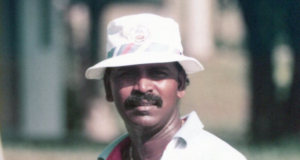BY GEORGE DAS
(www.mysportsflame.com)
Blue skies and a mild sun envelopes the Rizal Memorial Stadium in Manila that December of 1981.This was the stage for our meet-up.
Standing with me on that beautiful Monday morning at the edge of the athletics running track was M. Ramayah, the newly crowned champion of the Marcos Invitation Golf Tournament. I was in Manila to cover the South East Asian Games and Ramayah had come to see me.
Here was the new Asian sensation and “gentleman golfer” but the Malaysian athletes around us were oblivious of who he was.
Just a day earlier he had captured this prestigious title at the Gary Player designed challenging Puerto Azul Golf and Country club. At this challenging and picturesque course he had overcome an array of illustrious world stars.
It was no small feat. A really laudable achievement for the 26 year old unknown, unranked , undiscovered golfer who brought glory and honour to Malaysia.
Many, to this day are unaware of his outstanding performance which not only goes down in Malaysian golf annals but Asia too. He played in the shadows of Billy Casper, Frank Beard, Dave Hill, Lu Liang Huan, Lu Hsi Chuen, Keith Fergus (defending champion) and Europe’s hottest property – German Bernard Langer.
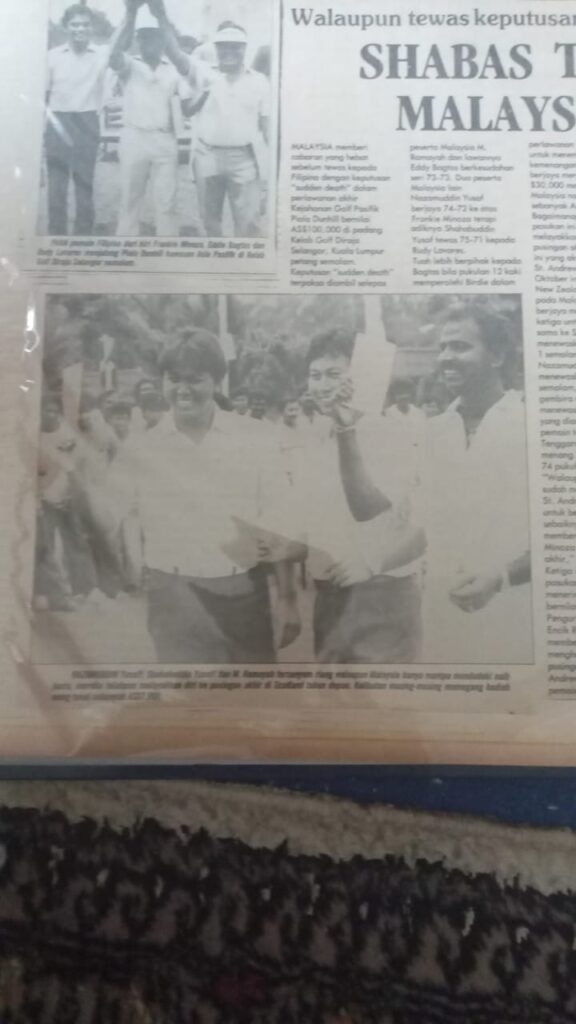
Ramayah was in the midst of all these million-dollar heavyweights. For the first two rounds of 74 and 72, he played with not much attention. All eyes were on Langer and Filipino Ben Arda.
He stole the thunder with a blistering six-under 65 for a course record that still stands to this day (the club has seen its good days and now is abandoned). Ramayah managed a three-day total of 2-under 211. Langer finished with a 4-over 215 (70,74, 71).
Langer, who led overnight was all set to take the title but it was not to be. He had nothing but praise: “Ramayah played very well especially in the final round.”
As we stood in the shade of the Rizal Stadium, I eagerly asked him how he felt coming away with the coveted crown. He modestly replied: “It makes me proud to have won outside my country. When you win at home, you get no recognition.”
He pocketed US$15,387 which included US$1000 for the course record and another US$1000 for the day’s lowest score. The organizers also accorded him the “champs’ room” at the exclusive Philippines Village Hotel.
Ramayah was quick to add: “It’s not the money which comes with the title. The joy of winning an international title matters more to me”.
He rightly proved to Malaysian doubters that local golfers are as good as others in the world.
Did he believe that he had an iota of a chance of winning! His reply was: “After the one-over 72 in the second round, I felt I had an outside chance.”
I have walked with Ramayah on that “rocky golf road.” It all started way back in 1975 when he became the Royal Selangor Golf Club (RSGC) caddie champion. As a child he picked stray golf balls before earning his caddieship.
With his childhood friends V. Nellan and K. Selaruas, they played under the moonlight every night. The 17th hole of RSGC Old Course which was adjacent to their homes was where they practiced most. Their parents were employed by the club to tend to the greens and club.

They possessed no golf clubs. So, they made makeshift clubs out off guava branches. Years later Ramayah was given a used 7-iron by a club member and this was the club that he so loved. He could play the whole course with just this one club.
Here, I would like to take a short journey back to when he was 7 years-old. This was when he began picking balls. Golf impressed his young mind. He had only one thought. A thought that became a dream. He wanted to be like the foreign professional golfers who traversed the Royal Selangor Golf Club course at the Malaysian Open in the 60s.
He followed them, he watched them and he emulated their every swing and stroke with his “guava club”.
He watched players like Frank Phillips, Peter Thomson, Tomor Ishii, Harold Henning, Ireneo Lagaspi who were recognized worldwide for their game.
Ramayah photographed their every stroke in his young mind as he followed them. This was the only way he studied golf. He received no professional teaching.
All these players sowed the seed of professional golf in him. He applied what he saw and modified to suit his style.
Though he did not have much formal education, his depth of golf was amazing. Golf was like second nature to him. He possessed so much natural talent that has never been seen in Malaysia.
Some called him a “magician”. He could manipulate the club with such ease – from a back swing to the thwack of the ball.
This was all in his wrist work just like the late 1970s badminton ace Punch Gunalan who had a punishing backhand wrist smash which opponents were unable to retrieve.
Holding a club, Ramayah came alive. He had a good feel of any club in his hands. Always in harmony with the clubs.
Golf gave him a purpose in life and the emotion of getting out of poverty.
After becoming the RSGC caddie champion, the following year in 1976, he turned professional. Played the Malaysian Open on his home course but failed to make the cut.
There were no rewards in his first year. He continued to work on his game for he knew it was a very competitive world out there. Being a perfectionist and disciplined, it helped his progress.
He never forgot his roots as a caddie. Life was difficult. Golf allowed him to escape the real harsh world.
Going into 1977, Ramayah showed his prowess to capture his first professional title — the Federal Flour Mills tournament on his home course, the RSGC.
“I caddied for Ramayah at this tournament and many others. I was amazed how he adapted himself to the different situations,” P Segaran, his young cousin recalled.
Segaran, who went on to become a pro golfer himself and now a teaching pro at Monterez Golf Club Driving Range, received “live” lessons from Ramayah. He would tell me “always walk fast but take your time for the next shot.”
From here Ramayah just continued to progress from tournament to tournament on the local scene, occasionally battling it out with the Yusof brothers — Nazamuddin and Sahabudin.
“Our rivalry continued for nearly three decades and he was my World Cup partner on three occasions. He was the best partner and we always discussed our golf game,” recalled Nazamuddin.
Brother Sahabudin had this to say: “A very talented and gifted golfer. He was of world standard. I dare say, he was much better than Vijay Singh.”
By the late 80s’, Ramayah was the dominant golfer in Malaysia and went on to play in 13 World Cup competitions. A record that could be around for a long time in Malaysia.
He failed to find recognition at home but in Korea, Japan, the Philippines and Singapore, he found admiration.
I remember travelling with Ramayah and Nazamuddin to the 1980 Mizuno Invitation in Japan and what a reception he received after the first round. The Japanese spectators were fascinated by him. They were totally awed every time he took a swing.
In the following years when he competed in Japan, he became a “star” attraction. The spectators just loved watching this unknown Malaysian golfer.
Everywhere he played he brought delight. His world revolved around golf and he brought happiness to the people watching him play.
He just couldn’t separate himself from golf. Even during his ‘last days’, suffering from spinal cancer, golf was still on his mind.
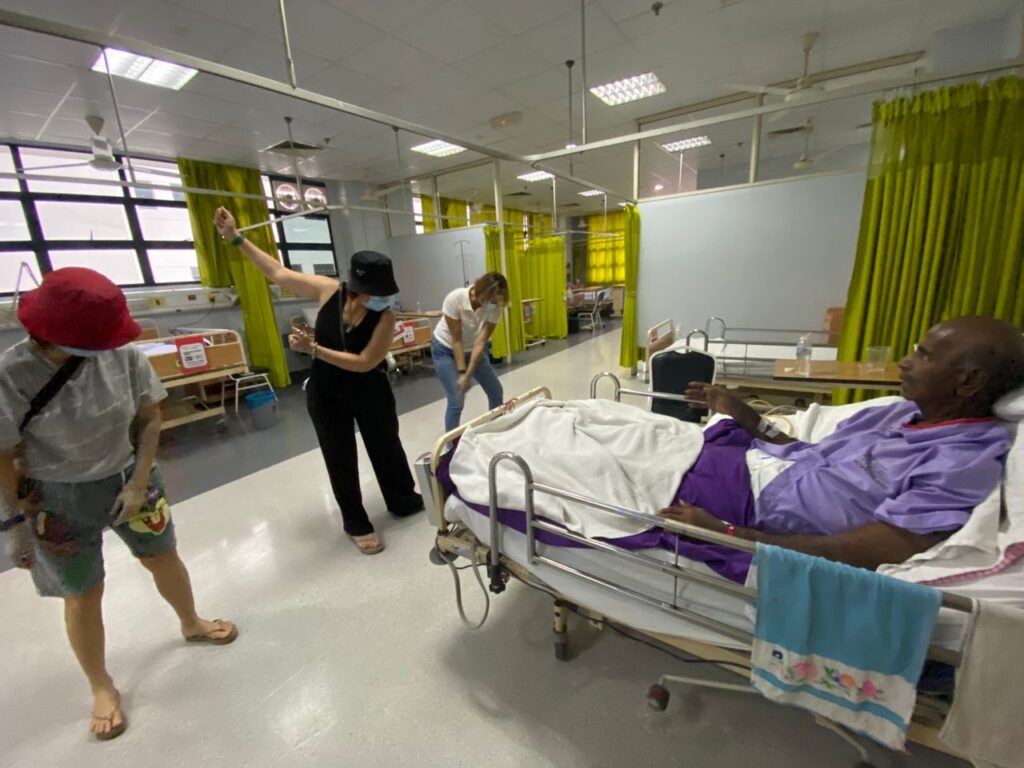
There, lying in hospital, with pain streaking through his frail body, he was correcting the swing of the visitors, who were his students. You could see him smile. For the joy of golf overcame the intense pain.
The way he saw it. The way he looked at it. The way he felt it. And the way he wanted to do it, is how I saw Ramayah.
Golf was a song and the clubs striking the ball was music to him.
Professional golf was his dream as a little bare-foot boy. I believe Ramayah achieved that dream.
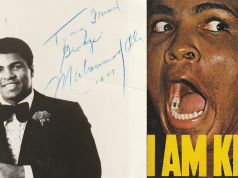


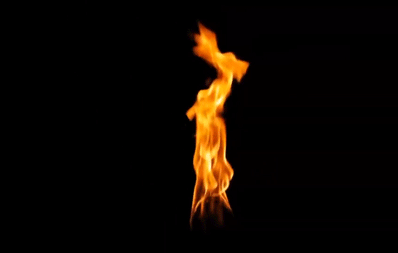 If you have an interesting personal story of a sports personality with photographs and video, we would like to publish it on this site.
If you have an interesting personal story of a sports personality with photographs and video, we would like to publish it on this site.


